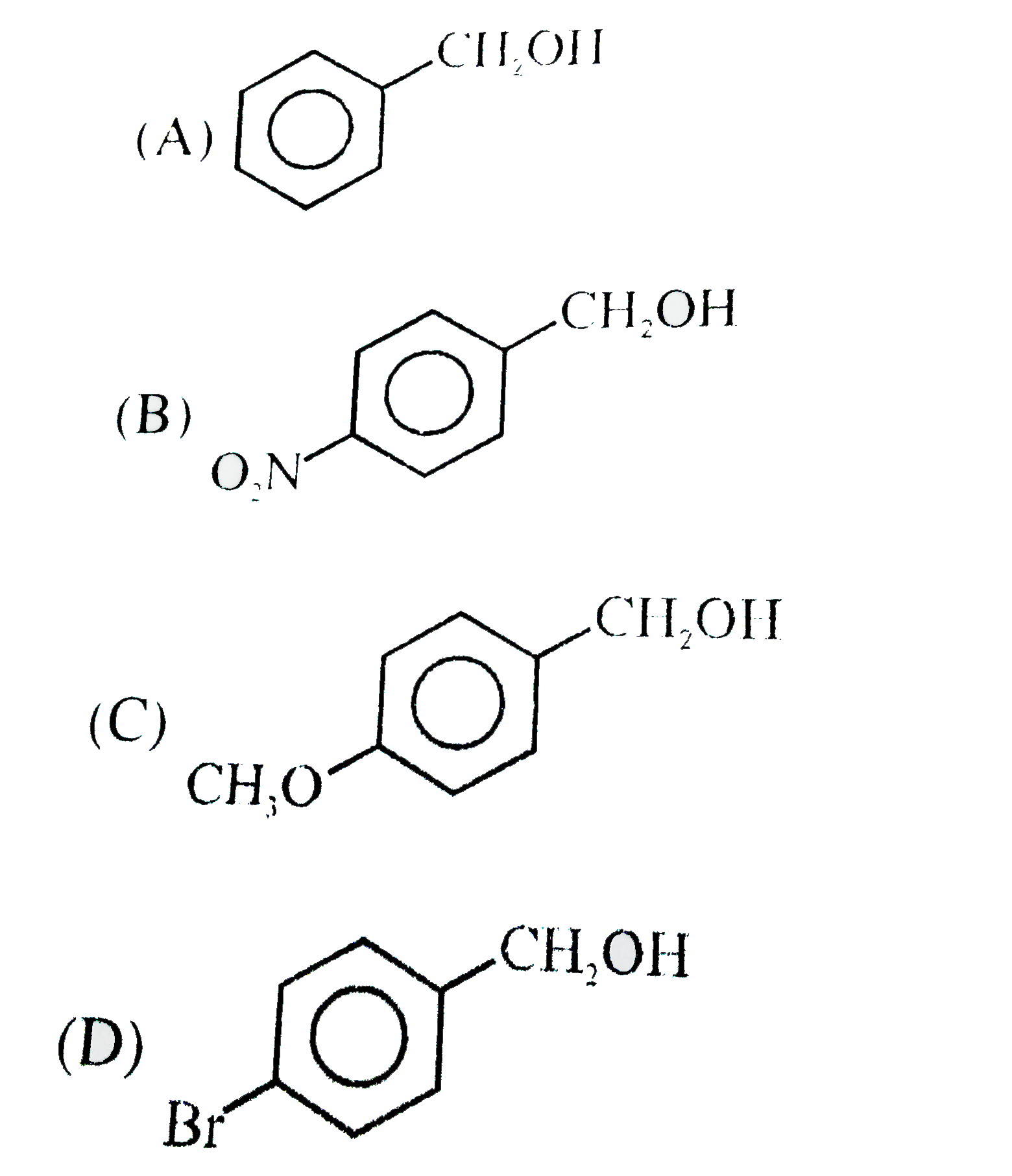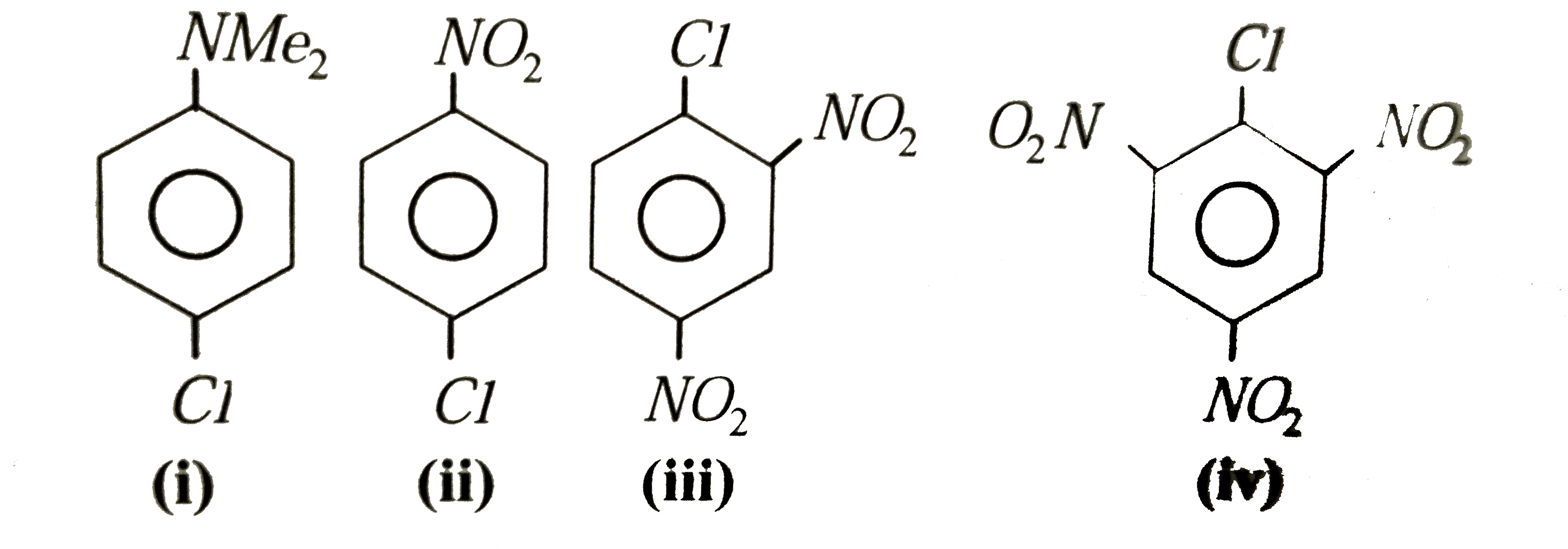Arrange the following compounds according to reactivity towards nucleophillic substitution reaction with reagents mentioned :-
4-nitrochlorobenzene> 2,4 dinitrochlorobemzene > 2,4,6, trinitrochlorobenzene with
To arrange the given compounds according to their reactivity towards nucleophilic substitution reactions with the nucleophile CH3O−Na, we need to analyze the influence of the nitro groups on the reactivity of each compound. Here’s a step-by-step solution:
Step 1: Understand the Nucleophile
The nucleophile in this reaction is CH3O−, which is the methoxide ion. This ion is a strong nucleophile and will attack the electrophilic carbon in the aromatic ring where the chlorine atom is attached.
Step 2: Identify the Compounds
The compounds we need to analyze are:
1. 4-Nitrochlorobenzene
2. 2,4-Dinitrochlorobenzene
3. 2,4,6-Trinitrochlorobenzene
Step 3: Analyze the Effect of Nitro Groups
The nitro group (−NO2) is a strong electron-withdrawing group due to its -I (inductive) and -M (mesomeric) effects. The more nitro groups present on the benzene ring, the more electron-deficient the ring becomes, making it more reactive towards nucleophiles.
- 4-Nitrochlorobenzene: Contains one nitro group that withdraws electron density from the ring, making it moderately reactive.
- 2,4-Dinitrochlorobenzene: Contains two nitro groups, which significantly increase the electron-withdrawing effect, making the ring more reactive than 4-nitrochlorobenzene.
- 2,4,6-Trinitrochlorobenzene: Contains three nitro groups, resulting in the highest electron deficiency of the ring, making it the most reactive towards nucleophilic substitution.
Step 4: Arrange the Compounds by Reactivity
Based on the analysis of the electron-withdrawing effects of the nitro groups, we can arrange the compounds in order of reactivity towards nucleophilic substitution with CH3O−Na:
1. 2,4,6-Trinitrochlorobenzene (most reactive)
2. 2,4-Dinitrochlorobenzene
3. 4-Nitrochlorobenzene (least reactive)
Final Answer
The order of reactivity towards nucleophilic substitution with CH3O−Na is:
2,4,6-Trinitrochlorobenzene > 2,4-Dinitrochlorobenzene > 4-Nitrochlorobenzene
---
The nucleophile in this reaction is CH3O−, which is the methoxide ion. This ion is a strong nucleophile and will attack the electrophilic carbon in the aromatic ring where the chlorine atom is attached.
The compounds we need to analyze are:
1. 4-Nitrochlorobenzene
2. 2,4-Dinitrochlorobenzene
3. 2,4,6-Trinitrochlorobenzene
The nitro group (−NO2) is a strong electron-withdrawing group due to its -I (inductive) and -M (mesomeric) effects. The more nitro groups present on the benzene ring, the more electron-deficient the ring becomes, making it more reactive towards nucleophiles.
- 2,4-Dinitrochlorobenzene: Contains two nitro groups, which significantly increase the electron-withdrawing effect, making the ring more reactive than 4-nitrochlorobenzene.
- 2,4,6-Trinitrochlorobenzene: Contains three nitro groups, resulting in the highest electron deficiency of the ring, making it the most reactive towards nucleophilic substitution.
Based on the analysis of the electron-withdrawing effects of the nitro groups, we can arrange the compounds in order of reactivity towards nucleophilic substitution with CH3O−Na:
2. 2,4-Dinitrochlorobenzene
3. 4-Nitrochlorobenzene (least reactive)
The order of reactivity towards nucleophilic substitution with CH3O−Na is:
2,4,6-Trinitrochlorobenzene > 2,4-Dinitrochlorobenzene > 4-Nitrochlorobenzene
Topper's Solved these Questions
- HALOALKANES AND HALOARENESBook:CBSE COMPLEMENTARY MATERIALChapter:HALOALKANES AND HALOARENESExercise:LONG ANSWER TYPE QUESTIONS (5 Marks)
Explore 5 Videos
- GENERAL PRINCIPLES AND PROCESSES OF ISOLATION OF ELEMENTSBook:CBSE COMPLEMENTARY MATERIALChapter:GENERAL PRINCIPLES AND PROCESSES OF ISOLATION OF ELEMENTSExercise:Short Answer-II Type Questions
Explore 5 Videos
- P-BLOCK ELEMENTSBook:CBSE COMPLEMENTARY MATERIALChapter:P-BLOCK ELEMENTSExercise:LONG ANSWER TYPE QUESTIONS
Explore 15 Videos
Similar Questions
Knowledge Check
Arrange the following compound for their reactivity toward nucleophilic substitution with HBr ?
 AA>B>C>DBC>A>D>BCD>C>B>ADB>D>A>C
AA>B>C>DBC>A>D>BCD>C>B>ADB>D>A>CArrange the following compound in reactivity towards EAS (Electrophilic aromatic substitution) reaction ?
 AA>B>C>DBB>C>A>DCD>C>B>ADC>B>D>A
AA>B>C>DBB>C>A>DCD>C>B>ADC>B>D>AWhich of the following halideso is most reactive towards nucleophilic substitution reaction?
AC2H5BrBC2H5ClCC2H5FDC2H5I
Arrange the following in order of their incresing ractivity towards nucleophilic substitution reaction:
View SolutionWhich of the following compounds is most reactive towards nucleophilic acyl substitution :-
View SolutionWhich of the following compounds is most reactive towards nucleophilic addition reactions?
View SolutionWhich of the following compounds is most reactive towards nucleophilic addition reactions?
View SolutionWhich of the following compounds is most reactive towards nucleophilic addition reactions ?
View Solution

